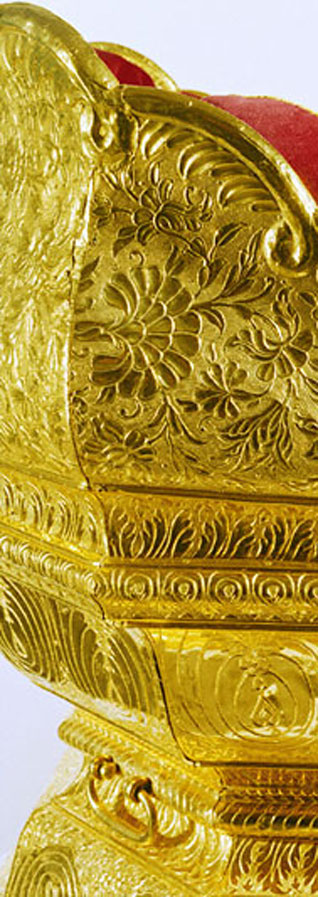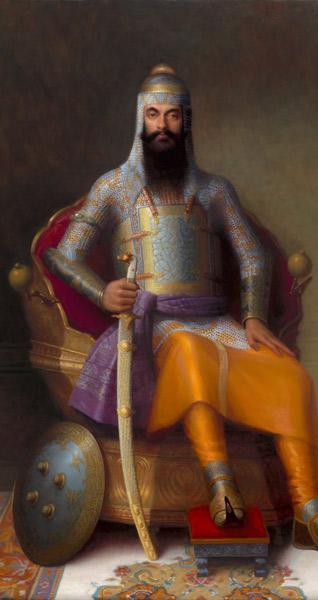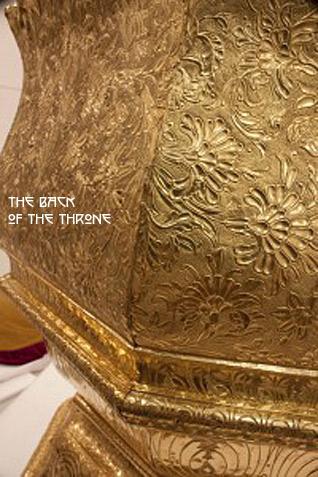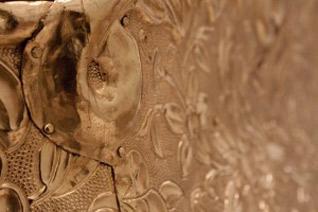
Images below: first and second from bottom - by Jasprit Singh. Third from bottom - detail from life-size oil painting of Ranjit Singh seated on his throne, by Manu Kaur Saluja. It is currently on loan to The Royal Ontario Museum, Toronto, Canada.



Art
Singhasan: Throne of the Lion
by AMANDEEP SINGH MADRA
One of the most iconic symbols of Maharaja Ranjit Singh's 19th century kingdom - indeed, of recent Sikh history - is the golden throne, now safely housed in London's Victoria & Albert Museum (V & A). It is on permanent display in the museum and arguably is one of their most important objects.
Over the next few months the Golden Throne will form part of the dazzling ‘Maharaja Exhibition' that runs from October to December and will ultimately tour to Germany and Canada.
I was given the rare privilege of examining the throne close-up, outside of its normal glass case, a few weeks ago. I would like to share some of the pictures (taken by Jasprit Singh) and some of its history.
Seeing the throne close-up is a real pleasure, the fact that it is in existence at all is a miracle. Few other communities as young as the Sikhs have lost so much of their material heritage and whilst Britain today (most notably the V&A) does a world-class job in preserving Sikh heritage, our country's predecessors were not quite so benevolent.
When the Toshkhana (treasury) of the Sikh Kingdom was raided following the annexation of the Punjab in 1849, the East India Company and its head, Lord James Dalhousie, were near bankruptcy. The royal treasury was a literal gold mine for them and they quickly saw a chance to mend the battered finances of the company.
Dalhousie had his secretary, Dr John Login, prepare a detailed inventory of the contents of the toshkhana; Login was blinded by the riches within, commenting on the "vast quantities of gold, silver, the jewels not to be valued, so many and so rich! ... and perhaps above all, the immense collection of magnificent Cashmere shawls, rooms full of them laid out on shelves, and heaped up in bales - it is not to be described".
This was not to be a careful listing of a rich artistic tradition or an attempt to carefully document a vastly important collection for the future. It was a catalogue for a fire sale. Over nine heady days, Dalhousie auctioned off the vast bulk of the treasury. The larger bulkier items were problems; who would buy them, Dalhousie questioned: a silver pavilion caused a particular problem - so he had it malted down. The Dalhousie auctions remain one of the most egregious acts of cultural malevolence in history.
Not so for the throne of Ranjit Singh - a remarkable and unique item that stood out from the multitudes of plump jewels and crafted weapons. Dalhousie initially attempted to keep the throne for himself and reported to the British Government that ‘It is set apart as an object which the court would probably desire to preserve, but as it is bulky, I shall not forward it until I receive orders to do so'.
The government saw through his ruse and demanded it be sent to London with the other treasures that were deemed too precious to be auctioned (including the Koh-i-Noor) but not before Dalhousie commissioned a replica of the throne carved in wood for his own collection.
The Golden Throne was made for Maharaja Ranjit Singh by a Muslim goldsmith, Hafez Muhammad Multani, between approximately 1820 and 1830. The craftsman decorated thick sheets of pure gold with a design of flowering plants that cover the wooden core of the throne.
Hafez Muhammad must have been a leading goldsmith of the Lahore court as he is mentioned twice in the detailed inventories made of the treasury when the Punjab and Sikh crown property was annexed by the East India Company in 1849.
It was shipped to the Indian Museum in London. In 1879, Ranjit Singh's Golden Throne moved to the South Kensington Museum, later renamed the Victoria and Albert Museum.
The throne is breathtaking in its execution. A wooden substructure is covered in deeply reliefed, solid gold sheets; the decoration is rich and dripping with symbolism. The throne itself is in the form of an opening lotus flower - a metaphor regularly used in Sikh scripture where the Gurus enjoin Sikhs to live in the world as the lotus flower blooms in murky waters; that is, to live in the world unaffected by the world's attachments.
The decoration repeats this motif around the base. Ranjit Singh, seated in this throne, during his public durbars would have been a glittering sight.
Close up, the detail of the throne is readily visible and even for someone like me, who has seen it countless times at the museum, I was struck by the sheer opulence of the work on the back of the throne which is sadly barely visible in the current display case.
In preparation for the Maharaja Exhibition, the throne was in the conservation department for cleaning. This was being painstakingly carried out by the V&A's head of metalwork conservation, Diana Heath. I am always struck at the precision and professionalism of conservation experts and Diana's work on the throne was just enough to clean ten years of light dust without attempting to interfere with the 200 years of patina that characterises the fold work - a sharp contrast to the disastrous and heavy handed re-gilding of the Harmandir Sahib in 1999.
I hope that when it returns from its exhibition and tour around the world as part of the Maharaja Exhibition, it is back on public display in a manner that will allow every visitor to experience the masterpiece that is Ranjit Singh's Singhasan - Throne of the Lion.
 
[Courtesy: www.punjabheritage.org]
October 14, 2009
Conversation about this article
1: Jagdish Singh (Bayside, U.S.A), October 14, 2009, 12:05 PM.
The throne should be returned to the Sikhs ... it belongs to us. [Editor: The question is - Who specifically should it be given back to? Until that is decided to the satisfaction of the Sikh populace, it's safest in the V & A. Remember, it was the Indian government that plundered the Darbar Sahib's Toshakhana in 1984! And, do you trust the S.G.P.C.? Or the Punjab government?]
2: Tarsem Singh Ubhi (U.K.), October 14, 2009, 3:51 PM.
I agree with the editor. Absolutely right! It should not be allowed to return to India or Lahore. It is safest in the U.K. After all, haven't we got a sizeable Sikh population (taxpaying citizens) here who can also lay a claim to it?
3: Dhanwant Mundae (Calgary, Alberta, Canada), October 14, 2009, 5:37 PM.
The editor is absolutely right. I don't think these treasures are safe in India or Pakistan.
4: Mai Harinder Kaur (Seattle, U.S.A.), October 14, 2009, 6:53 PM.
I personally hope that some day it will be returned to us in Khalistan. Until then, it should stay with the British who are experts in caring for historical objects.
5: Taranjit Singh (Kashmir), October 15, 2009, 3:09 AM.
Should be called the "Throne of the Lion", in exile.
6: Kulbir Colin Singh Dhillon (Caledon, Ontario, Canada), October 17, 2009, 7:08 PM.
Preservation of our rich heritage is most critical for the future of both our faith and culture. I firmly believe that items that have been taken away from the Sikh Kingdom, and currently held in museums in London, Paris, etc., are in fact saved, for they would otherwise have been lost to us and the world ... Beautiful description, Amandeep. Thank you.
7: Manpreet Singh (Richmond, U.K.), October 21, 2009, 10:11 AM.
I agree with the editor absolutely. So many historical objects have been lost or melted down whilst in India or Pakistan. Although the British may have originally had a different motive, the fact is that these objects have been saved and preserved in the U.K. If you see the various museums in the gurdwaras in India, like I just have, and seen the condition the historical artifacts are kept in and then compare that to the U.K., you will see for yourself. Many fellow Sikh will agree, I'm sure, that the the Brits are the best custodians for the time being.


